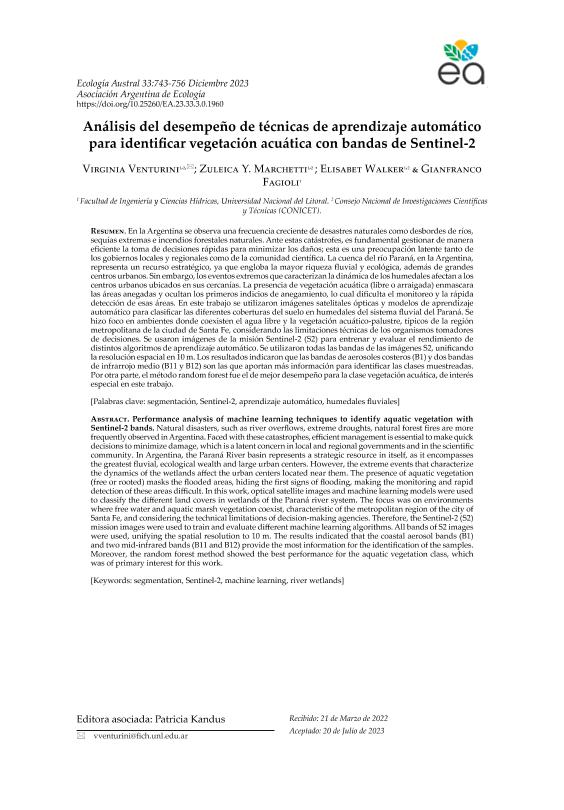Artículo
Los desastres naturales, como los desbordes de los ríos, las sequías extremas, los incendios forestales naturales se observan con mayor frecuencia en Argentina. Frente a estas catástrofes, es fundamental una gestión eficiente que tome decisiones rápidas para minimizar los daños, lo cual es una preocupación latente en los gobiernos locales y regionales y en la comunidad científica. En la Argentina, la cuenca del río Paraná representa un recurso estratégico en sí mismo, ya que engloba la mayor riqueza fluvial y ecológica, junto a grandes centros urbanos. Sin embargo, los eventos extremos que caracterizan la dinámica de los humedales afectan a los centros urbanos ubicados cerca de los mismos. La presencia de vegetación acuática (ya sea libre o arraigada) enmascara las áreas anegadas ocultando los primeros indicios de anegamiento, así el monitoreo y rápida detección de dichas áreas se dificulta. En este trabajo se utilizaron imágenes satelitales ópticas y modelos de aprendizaje automático para la clasificación de las diferentes coberturas del suelo en humedales del sistema fluvial del Paraná. Se hizo foco en ambientes donde coexisten el agua libre y la vegetación acuático-palustre típicos de la región metropolitana de la ciudad de Santa Fe, considerando las limitaciones técnicas de los organismos tomadores de decisiones. Así, se utilizaron imágenes de la misión Sentinel 2 (S2) para entrenar y evaluar el rendimiento de distintos algoritmos de aprendizaje automático. Se utilizaron todas las bandas de las imágenes Sentinel 2 unificando la resolución espacial en 10 m. Los resultados indicaron que las bandas de aerosoles costeros (B1) y dos bandas de infrarrojo medio (B11 y B12), son las que mayor información aportan para la identificación de las clases muestreadas. Por otra parte, el método Random Forest fue el que mejor desempeño mostró para la clase vegetación acuática, de especial interés en este trabajo. Natural disasters, such as river overflows, extreme droughts, natural forest fires are more frequently observed in Argentina. Faced with these catastrophes, efficient management is essential to make quick decisions to minimize damage, which is a latent concern in local and regional governments and in the scientific community. In Argentina, the Paraná River basin represents a strategic resource in itself, as it encompasses the greatest fluvial, ecological wealth and large urban centers. However, the extreme events that characterize the dynamics of the wetlands affect the urban centers located near them. The presence of aquatic vegetation (free or rooted) masks the flooded areas, hiding the first signs of flooding, making the monitoring and rapid detection of these areas difficult. In this work, optical satellite images and machine learning models were used to classify the different land covers in wetlands of the Paraná river system. The focus was on environments where free water and aquatic marsh vegetation coexist, characteristic of the metropolitan region of the city of Santa Fe, and considering the technical limitations of decision-making agencies. Therefore, the Sentinel-2 (S2) mission images were used to train and evaluate different machine learning algorithms. All bands of S2 images were used, unifying the spatial resolution to 10 m. The results indicated that the coastal aerosol bands (B1) and two mid-infrared bands (B11 and B12) provide the most information for the identification of the samples. Moreover, the random forest method showed the best performance for the aquatic vegetation class, which was of primary interest for this work.
Análisis del desempeño de técnicas de aprendizaje automático para identificar vegetación acuática con bandas de Sentinel-2
Título:
Performance analysis of machine learning techniques to identify aquatic vegetation with Sentinel-2 bands
Fecha de publicación:
12/2023
Editorial:
Asociación Argentina de Ecología
Revista:
Ecología Austral
ISSN:
0327-5477
Idioma:
Español
Tipo de recurso:
Artículo publicado
Clasificación temática:
Resumen
Palabras clave:
SEGMENTACIÓN
,
SENTINEL 2
,
HUMEDALES FLUVIALES
,
APRENDIZAJE AUTOMATICO
Archivos asociados
Licencia
Identificadores
Colecciones
Articulos(CCT - SANTA FE)
Articulos de CTRO.CIENTIFICO TECNOL.CONICET - SANTA FE
Articulos de CTRO.CIENTIFICO TECNOL.CONICET - SANTA FE
Citación
Venturini, Virginia; Marchetti, Zuleica Yael; Walker, Elisabet; Fagioli, Gianfranco; Análisis del desempeño de técnicas de aprendizaje automático para identificar vegetación acuática con bandas de Sentinel-2; Asociación Argentina de Ecología; Ecología Austral; 33; 3; 12-2023; 743-756
Compartir




